The snorkeling areas on Hawaii Big Island are among the greatest in the Hawaiian Islands. On the western side of the island (Kona side), several protected volcanic coves dot the shoreline, where corals, reef fish, and bigger marine life flourish! Swimming with manta rays at night is a once-in-a-lifetime experience, as is marveling at one of nature’s gentlest giants. During the day, don’t miss out on the many other wonderful snorkeling spots on the Big Island! Read on below and find out what they are.
Manta Ray Night Snorkel

Swimming with the amazing manta rays at Manta Village is probably the biggest lure for nature enthusiasts visiting the seas of Kailua-Kona. Manta alfredi, or reef manta rays, are the second-largest manta ray species on the planet and are regularly spotted in Hawaiian waters. Mantas are filter feeders, sucking plankton into their enormous jaws. The Kona group does not migrate and remains permanently in these tropical waters.
Around sunset, boats leave Kona’s harbors and head to one of two locations known as “Manta Village” or “Manta Heaven,” where they shine lights into the ocean and put up massive rafts with floodlights pointing down into the waters. The light pulls diurnal plankton to the surface, attracting groups of manta rays to graze on their evening meal. Snorkelers cling to the sides of the rafts, watching as these gentle giants swim and turn in circles, feasting on the plankton soup below. It’s an incredible experience and sight to witness. When visiting the Big Island, make this your top priority!
Kealakekua Bay (Captain Cook)

Kealakekua Bay is the only underwater state park on the Big Island and one of Hawaii’s best snorkeling spots! It’s not very easy to get there from the land because the parking lot is 1.9 miles distant from the bay, requiring a long journey down to the water in the blazing sun, followed by a climb back up when you’re done. The ideal way to get to the bay is by boat, which allows you to see the gorgeous coastline from the water and allows you to visit the region’s greatest snorkeling locations.
Snorkeling equipment, snacks, refreshments, and a wealth of intriguing cultural, historical, and critical information about the area are all included on some boat cruises. Another alternative is to rent a kayak and paddle out to the bay’s outer reaches to snorkel with a permit. Spinner dolphins, sea turtles, lizard fish, eels, and stunning corals are frequently seen at this spot, which has exceptional visibility.
Native Hawaiians revere Kealakekua Bay as a sacred site, and it was here that Captain Cook made his second touchdown in Hawaii during the makahiki celebration. Captain Cook was mistaken for Lono, the fertility god, when his ships with white sails arrived in the bay, appearing eerily similar to the white kapa banners flying on crossbars that represent the god! Before leaving Hawai’i, Cook was showered with presents for two weeks. A kapu, or prohibition, had been placed on the bay after the makahiki ceremony, and Cook and his crew were obliged to return to the bay when they faced a violent storm.
The Hawaiians were dismayed by his return, believing that no deity could be defeated in his own domain, the sea, and took valued metals from his ships in compensation for the supplies they had freely provided to this false god. Cook sent nine sailors ashore in an attempt to capture Chief Kalaniopuu and demand the return of his valuables, but a battle ensued, and Cook and four of his men were killed on February 14, 1779. To honor him, the British built the Captain Cook Monument in the location where he died.
Honaunau Bay (Two Steps)
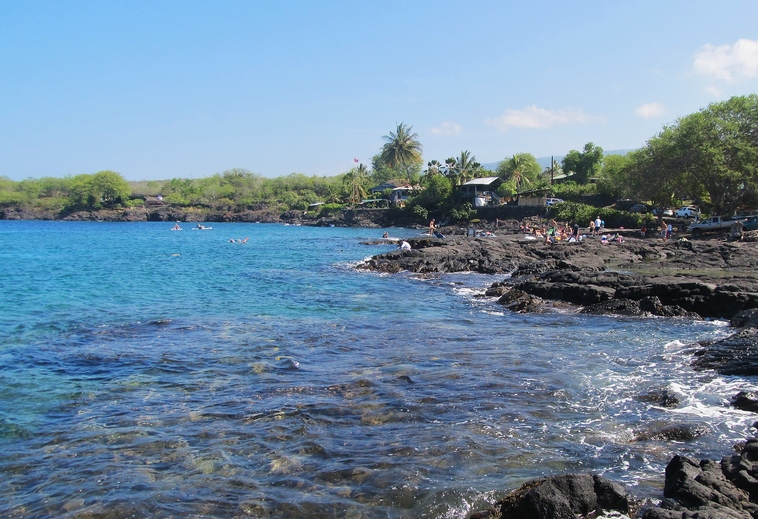
Honaunau Bay is a beautiful site to explore, with plenty of coral and water life. This beach was designated “America’s Best Beach” in 2004 for its crystal clear seas (up to 100 feet visibility). The 182-acre Pu’uhonua O Honaunau National Historical Park, from whence the name Honaunau is derived, is worth trekking through to see a preserved old Hawaiian town on the bay’s left side. This was a haven for Hawaiians who had broken the kapu, or holy laws, which may result in death. Once inside the Pu’uhonua bounds, one was safe and protected. The name literally means “City of Refuge.”
The bay’s entry is not from a beach, but rather from the farthest point of lava rock. To access the lava rock “stairs” into the ocean, put on your slippers and stroll out to the center of the lava rock (where other people will most likely be congregated). Once in the sea, there is a shallow region along the coast for beginner snorkelers with coral heads in 6-10 feet of water. Many different varieties of fish can be seen, as well as octopus! A deep sandy area further out includes a patch of cement blocks that have been molded to spell out “ALOHA.” Due to the two rock stairs that you will use to join the sea, the site was named “Two Steps!”
If you’re a more experienced snorkeler, head to the left of where you entered to explore coral reef canyons, channels, and walls (about 30 feet deep) where you’re likely to see honu or sea turtles. Surge waves might develop when entering and exiting the sea, so be cautious. Keep a watch on the reef since the seafloor drops swiftly to about 100 feet. Hawaiian spinner dolphins are known to rest in this harbor and are best spotted early in the morning!
It’s worth noting that the amenities here are extremely restricted. A few picnic tables and temporary facilities are available, but there are no food kiosks or showers.
Mauna Kea Beach, Kauna’oa Bay
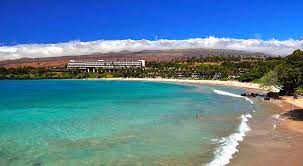
This is a site you shouldn’t miss because of its white beaches and the prospect of seeing manta rays! The Mauna Kea Beach Hotel, which is where the name comes from, is located in Kauna’oa Bay. The public beach is accessible through the hotel gate, where you may obtain a parking pass. Nevertheless, we recommend arriving early because there are only 10 parking places available! Visibility and snorkeling can be great when the conditions are favorable. Swim out through the shallow corals to access spectacularly gorgeous reefs filled with life from either side of the bay towards the rocks through the beach.
This is yet another area where you can see manta rays! In the evenings, the Mauna Kea Beach Hotel beams brilliant lights into the water to attract plankton, and manta rays frequently come to feed. Just after dusk, jump into the sea around “Manta Ray Point” for a chance to witness these gorgeous creatures. Please use particular caution at night and keep a close eye on the beach.
With its magnificent white sand beach, Mauna Kea Beach was selected as one of “The World’s All-Time Best Beaches” by Travel Channel, and it truly merits the honor!
Kahalu’u Beach Park
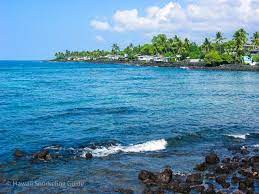
Because there is a lifeguard on duty and the waters are easily accessible, shallow, and sheltered, Kahalu’u Beach Park is an excellent spot for beginner snorkelers. There are many fish to be found, as well as tide pools to explore! The honu, or sea turtles, that frequent Kahalu’u Bay are known for feasting on limu, or seaweed, and sunbathing on the rocks.
When snorkeling, stay on the left side of the bay since surfers frequent the area when swells occur. The park is happy to work with volunteers to support the ReefTeach Program, which educates the public on how to care for honu and other reef species, as well as how to avoid injuring corals.
Another popular pastime is sunbathing, but this place is also one of the top three snorkeling spots on the Big Island. Sea urchins, octopus, eels, sea turtles, and a variety of Hawaiian fish species such as Racoon Butterflyfish, Hawaiian Spotted Boxfish, and Bullethead Parrotfish abound on the reef. The fish are accustomed to snorkelers and may approach you to say “Hello.” Showers, bathrooms, picnic tables, and a handful of shaded pavilions are among the amenities.
Hapuna Beach
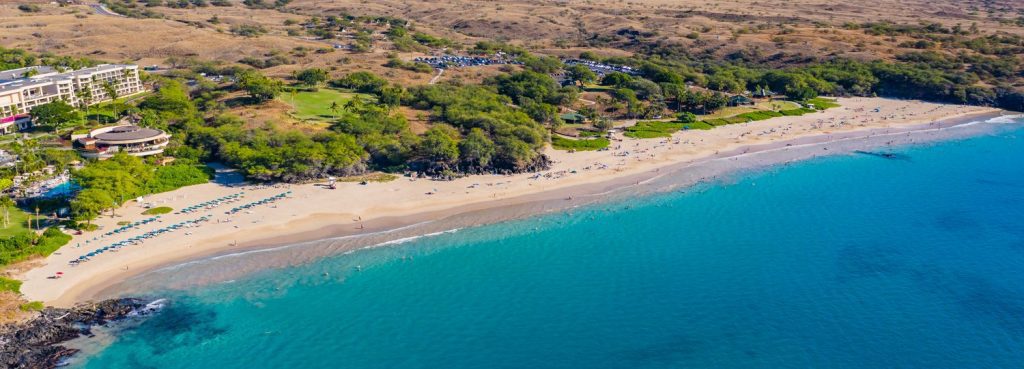
Hapuna Beach is one of Big Island’s most gorgeous white sand beaches, and it’s generally sunny! It stretches over a half-mile long and has two snorkel sites on either end! A lifeguard is on duty all year, making it an ideal beach for families. That said, it is a very popular spot with limited parking, so get there early. The beach is more exposed than other locations, resulting in stronger wave action and reduced visibility. This, combined with a long swim to the coral reefs at either end of the beach, makes this a more advanced snorkeling destination.
In the morning, most of the snorkeling spots near Kohala have the best conditions. Once you swim out to the corals on the north (right) end of the beach, there’s more to see in the shallows, with turtles and fish frequenting the waters near the rocky walls and canyons. The south (left) end of the beach also necessitates a long swim out to the corals, where there is a little cove filled with amazing coral formations and fish. Because you will be out of sight of the lifeguards here, please be cautious and return before becoming exhausted.
Currents and surges will become stronger as you go closer to the point on either side of the bay, which might be deadly if you aren’t prepared or become weary. Always go with a partner and stay in shallower waters. Even strong swimmers can tire out and get themselves into difficulty in deeper seas.
Waialea Bay (Beach 69)
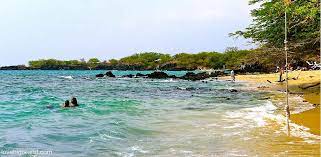
Waialea Bay, sometimes known as “Beach 69,” is just down the road and is more accessible and less congested than Hapuna Beach. In 1985, this location was classified as a marine life conservation district, and it included spectacular reefs. The ocean is usually calmer and visibility is better during the winter. On hot summer days, trees line the shore of the bay, providing shade from the sun. The sand tends to disintegrate in the winter, and heavier surf results in reduced visibility and unsafe snorkeling conditions.
This bay is more protected and tranquil than Hapuna Beach, and it features three separate snorkeling locations. Our favorite spot is the south end of the bay (on the left side), which is accessible from the beach and where many juvenile fish congregate in the shallower waters near the rocks. There are larger coral heads and wonderful reefs to explore as you swim out towards the point. Swim out behind the rocky point in the middle of the bay to a little coral reef on the opposite side, which is home to a variety of fish. In around 7-10 feet of water, you may loop around a rock outcropping on the left side and view healthy reefs with an abundance of fish. Follow the rocky point out from the right side of the beach toward the north end, where you can explore the coral fingers that reach out to a comfortable depth of around 15 feet.
During the winter, humpback whales are frequently seen from this location! The beach changes with the seasons – winter tides destroy the sand, but summer tides bring back the white sands!
Kamakahonu (King Kam Beach)
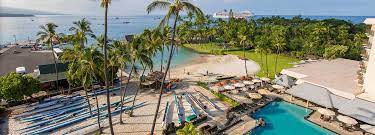
Kamakahonu Beach, also known as King Kam Beach, is a small, peaceful beach in the heart of Kailua-Kona. Swim out of the bay over to the right, entering from the beach (not near the rocky pier). Boats are more common on the left side of the bay, so swim left! Tangs, butterflyfish, and other tropical fish abound on the reef. There are other shops in the neighborhood that rent snorkeling equipment and offer Kona snorkeling cruises. Because it is easily accessible and tranquil, this is an excellent snorkeling spot for youngsters.
This bay on the north side of Kailua Bay is often referred to as “Kids’ Beach” because it is ideal for families with small children. The sand is white, the sea is normally calm, and there is a grassy space where kids can play. Although King Kam is not a beach where you would likely spend a complete day, many individuals who are early risers and interested in snorkeling on Big Island at daybreak will enjoy some spectacular underwater vistas. Visitors can also enjoy swimming, canoeing, and diving.
Richardson’s Ocean Park (near Hilo)

The east side of the Big Island has rougher seas than the west, resulting in less visibility and fewer sheltered bays and beaches good for snorkeling. Richardson’s Ocean Park, on the other hand, is protected from the waves and features a black sand beach and tide pools. The water is usually calm, and the spot is relatively shallow, with plenty of tropical fish and sea turtles! The seas are normally tranquil due to natural sea walls that create caverns and tidal pools, making this one of the best snorkeling spots on the Big Island. Monk seals are frequently observed in this area.
The sand is actually two colors: black from the lava rock and green from the olivine crystals! Although getting to this beach is not easy, if the green sand piques your attention, it is well worth your time.
